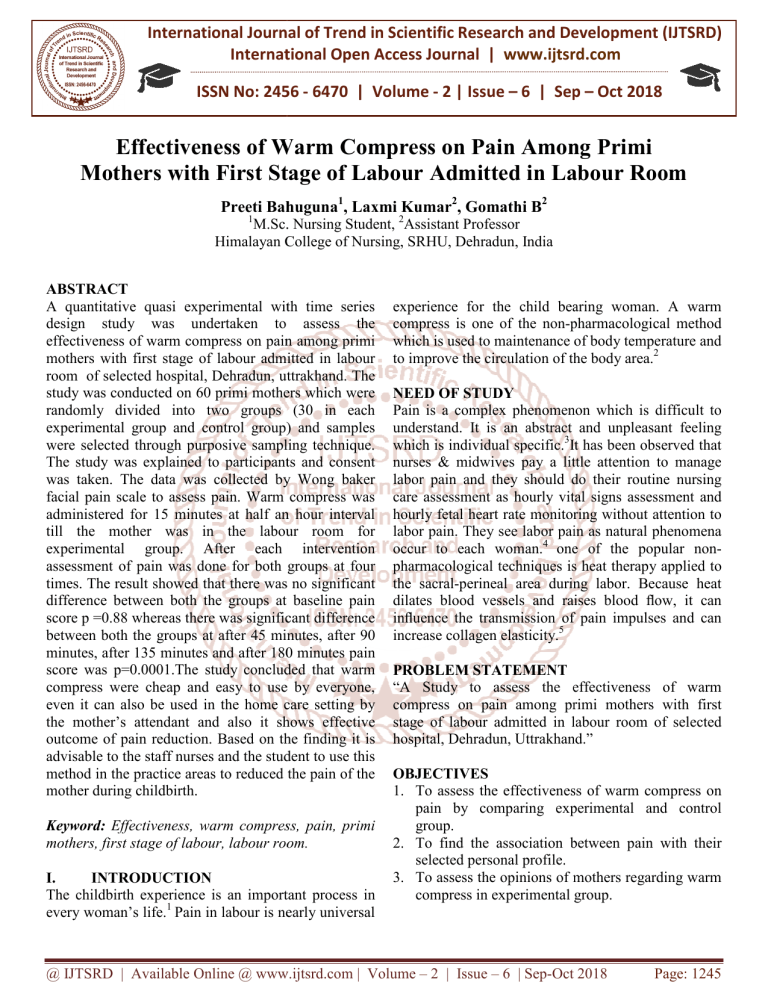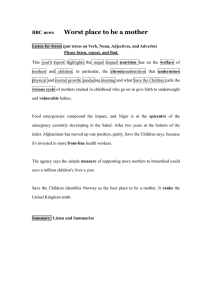
International Journal of Trend in Scientific Research and Development (IJTSRD)
International Open Access Journal | www.ijtsrd.com
ISSN No: 2456 - 6470 | Volume - 2 | Issue – 6 | Sep – Oct 2018
Effectiveness off Warm Compress on
n Pain Among Primi
Mothers with First Stage of Labour Admitted in
n Labour Room
Preeti Bahuguna1, Laxmi Kumar2, Gomathi B2
1
M.Sc.. Nursing Student, 2Assistant Professor
Himalayan College of Nursing, SRHU, Dehradun, India
ABSTRACT
A quantitative quasi experimental with time series
design study was undertaken to assess the
effectiveness of warm compress on pain among primi
mothers with first stage of labour admitted in labour
room of selected hospital, Dehradun, uttrakhand. The
study was conducted on 60 primi mothers which were
randomly divided into two groups (30 in each
experimental group and control
ontrol group) and samples
were selected through purposive sampling technique.
The study was explained to participants and consent
was taken. The data was collected by Wong baker
facial pain scale to assess pain. Warm compress was
administered for 15 minutes at half an hour interval
till the mother was in the labour room for
experimental group. After each intervention
assessment of pain was done for both groups at four
times. The result showed that there was no significant
difference between both the groups at baseline pain
score p =0.88 whereas there was significant difference
between both the groups at after 45 minutes, after 90
minutes, after 135 minutes and after 180 minutes pain
score was p=0.0001.The study concluded that warm
compress were cheap and easy too use by everyone,
even it can also be used in the home care setting by
the mother’s attendant and also it shows effective
outcome of pain reduction. Based on the finding it is
advisable to the staff nurses and the student to use this
method in the practicee areas to reduced the pain of the
mother during childbirth.
Keyword: Effectiveness, warm compress, pain, primi
mothers, first stage of labour, labour room.
I.
INTRODUCTION
The childbirth experience is an important process in
every woman’s life.1 Pain in labour is nearly universal
experience for the child bearing woman. A warm
compress is one of the non-pharmacological
pharmacological method
which is used to maintenance of body temperature and
to improvee the circulation of the body area.
area 2
NEED OF STUDY
Pain is a complex phenomenon which is difficult to
understand. It is an abstract and unpleasant
unpleasan feeling
which is individual specific.3It has been observed that
tha
nurses & midwives pay a little attention to manage
man
labor pain and they should do their routine nursing
care assessment as hourly vital signs assessment and
hourly fetal heart rate monitoring without attention to
labor pain. They see labor pain as natural phenomena
occur to each woman.4 one of the popular nonpharmacological techniques is heat therapy applied to
the sacral-perineal area during labor. Because heat
dilates blood vessels and raises blood flow, it can
influence
fluence the transmission of pain impulses and
a can
increase collagen elasticity.5
PROBLEM STATEMENT
“A Study to assess the effectiveness of warm
compress on pain among primi mothers with first
stage of labour admitted in labour room of selected
hospital, Dehradun, Uttrakhand.”
OBJECTIVES
1. To assess the effectiveness of warm compress on
pain by comparing experimental and control
group.
2. To find the association between pain with their
selected personal profile.
3. To assess the opinions of mothers regarding warm
compress in experimental group.
@ IJTSRD | Available Online @ www.ijtsrd.com | Volume – 2 | Issue – 6 | Sep-Oct
Oct 2018
Page: 1245
International Journal of Trend in Scientific Research and Development (IJTSRD) ISSN: 2456-6470
2456
HYPOTHESES
All
ll hypotheses were tested at p< 0.05 level of
significance
H1 – There would be significant reduction in the
mean pain score among primi mothers in
experimental group than in control group.
H2– There would be significant association between
pre interventional pain score wit
with selected
personal profile of primi mothers.
intervention assessment of pain was done for
fo both
groups at four times. The data were collected with the
help of various tools consisting:
consisting
II.
METHODOLOGY
The research design
sign used in this study was quasi
experimental with time series design. The study was
conducted at Himalayan Hospital, Dehradun,
Uttrakhand.60 primi mothers were randomly assigned
into 30 in experimental and 30 in control group
through purposive sampling technique. The data was
collected by Wong baker facial pain scale to assess
pain.. Women were explained the proc
procedure and
purpose of the study & written informed consent was
taken. Warm compress was administered for 15
minutes at half an hour interval till the mother was in
the labour room for experimental group. After each
Section B. Wong baker facial pain scale
Section A. Personal profile:
consists of Age, Educational status, , Occupational
status, Area of living, Type of family,
family Presentation of
fetus, Gestational age, Onset of labour and Life style
pattern.
Section C. Opionionnaire:
To assess the opinion of experimental group regarding
warm compress.
The content validity of the tool was ensured by giving
the tool to experts in the field of nursing and medical.
Reliability of tool was established by inter
observation
n method with Karl
K
Pearson test. The
reliability of Wong baker facial pain scale was r=
0.84.
III.
RESULT
The analysis and interpretation of the observation are given in the following section.
3.1Section I:
Description of personal profile of study participants
Table no. 1: Frequency and percentage distribution of personal profile of study participants.
participants
N= 60
Experimental Group Control group Homogeneity
S.
Personal profile
No.
Freq.
%
Freq.
%
χ2
p-value
Age (in years)
1. a) 19-27 years
22
73.3
22
73.3
0.901 0.371˟
b) 28-36 years
08
26.7
08
26.7
Educational status
a) No formal education
02
6.67
00
0
2. b) Primary education
02
6.67
04
13.33
6.825 0.271*
c) Secondary education
07
23.33
07
23.33
d) Graduation & above
19
63.33
19
63.34
Occupational status
3. a) Housewife
23
76.67
26
86.67
0.225*
b) Working
07
23.33
04
13.33
Area of living
4. a) Urban
18
60
22
73.33
0.678*
b) Rural
12
40
08
26.67
Type of family
a) Nuclear
08
26.67
07
23.33
5.
b) Joint
22
73.33
23
76.67
1.000*
c) Extended
00
0
00
0
@ IJTSRD | Available Online @ www.ijtsrd.com | Volume – 2 | Issue – 6 | Sep-Oct
Oct 2018
Page: 1246
International Journal of Trend in Scientific Research and Development (IJTSRD) ISSN: 2456-6470
2456
Presentation of fetus
a) Cephalic presentation
6. b) Breech presentation
c) Transverse presentation
d) Oblique presentation
Gestational age (in weeks)
7. a) < 37 weeks
b) > 37 weeks
Onset of labour
8. a) Spontaneous
b) Induced
Life style pattern
a) Sedentary
9.
b) Moderate
c) Severe
df1=3.84 at p<0.05 level of significance
25
04
01
00
83.33
13.34
3.33
0
28
02
00
00
93.33
6.67
0
0
11
19
36.7
63.3
09
21
13
17
43.33
56.67
3
22
5
10
73.33
16.67
1.417
1.000*
30
70
0.472
0.639˟
14
16
46.67
53.33
0.475
0.713
2
21
7
6.67
70
23.33
1.414
1.000*
jority of the mothers (73.33%) in
Chi-square
square test, * Fisher’s exact test, • Y
Yate’s shows majority
correction test and ˟ Independent t-test
test
experiment group & (70%)
70%) in control group were with
Table No. 1 shows majority of the mothers (73.3%) in moderate pattern.
experimental group and control group were 28
28-36
Chi square test, Fishers exact test, Yate’s correction
years of age. Educational status shows majority of the
test and Independent t-test
test were performed to find the
mothers (63.33%) in experiment group and control
homogeneity between experimental and control
cont
group were graduated & above. Occupational status
groups. It revealed that there was no significant
shows majority
ajority of the mothers (76.67%) in
difference between experimental and control groups
experiment group & (86.67%) in control group were
in terms of distribution of age (t=0.901; p=0.371),
housewives. Area of living shows majority of the
educational status (χ2 = 6.825; p = 0.271),
mothers (60%) in experimental group & (73.33%) in
occupational status (p = 0.225), area of living (p =
control group were from urban area. Type of family
0.678),
678), type of family (p = 1.000), presentation of
shows majority of the mothers (73.33%) in
fetus (χ2 = 1.417; p = 1.000), gestational age (t=0.472;
experiment group & (76.67%) in control group were
p=0.6/7439), onset of labour (χ2 = 0.475; p = 0.713),
from joint family. Presentation of fetus shows most of
and life style pattern (χ2 = 1.414; p = 1.000).
the mothers (83.33%) in experiment group &
(93.33%) in control group were with cephalic Hence it can be interpreted that the study participants
part
presentation. Gestational age shows majori
majority of the in experimental and control group were homogenous.
mothers (63.3%) in experimental group & (70%) in
Section II: Analysis based on the objectives
control group were > 37 weeks. Onset of labour
3.2 Objective 1:
shows majority of the mothers (56.67%) in
To assess the effectiveness of warm compress on pain
experiment group & (53.33%) in control group were
by comparing experimental and control group.
undergone induction of labour. Life style pattern
Table no. 2: Comparison of level of pain scores between and within experimental and control group.
Pain score (Mean ± SD)
F value
Groups
(p
After 45
After 90
After 135
After 180
Baseline
value)٭
minutes
minutes
minutes
minutes
Experimental
6.20 ±
68.822
2.60 ± 1.070
2.80 ±1.126
2.40 ± 0.814
2.13 ± 0.507
group
1.606
(0.0001)
6.13 ±
4.214
Control group
6.13 ±
±1.570
5.87 ±1.479
6.20 ± 1.324
7.07 ±1.143
±
1.814
(0.007)
t- value
0.151
10.187
9.033
13.397
21.612
(p value)†
(0.881)
(0.0001)
(0.0001)
(0.0001)
(0.0001)
†Independent tt- test٭Repeated measure ANOVA test
t58= 2.00 at p<0.05 level of significance
@ IJTSRD | Available Online @ www.ijtsrd.com | Volume – 2 | Issue – 6 | Sep-Oct
Oct 2018
Page: 1247
International Journal of Trend in Scientific Research and Development (IJTSRD) ISSN: 2456-6470
The t-test
test revealed that there was no significant
difference between both the groups at baseline pain
scores whereas there was significant difference
between both the groups at after 45 minutes, after 90
minutes, after 135 minutes and after 180 minutes pai
pain
score.
Hence, the null hypothesis was rejected and the
research hypothesis was accepted. Thus it can be
interpreted that experimental group have rapidly
decrease the level of pain as compared to the control
group. Itt showed that experimental group inter
intervention
is effective to reduce pain level.
3.3 Objective 2: To find the association between
pain with their selected personal profile.
The study result shows that there was no significant
association between personal profile and pain. Hence
the null hypothesis was accepted and the research
hypothesis was rejected. Thus it can be interpreted
that personal profile did not have any influence on
pain score of primi mothers.
3.4 Objective 3: To assess the opinions of mothers
regarding warm compress in experimental group.
Table No. 12: Frequency and percentage distribution of Oppinionnaire of mothers regarding warm
compress in experimental group.
N= 30
Strongly Agree
Agree
S. No.
Opinion
Freq.
%
Freq.
%
1.
I felt safe when receiving the warm compress.
24
80
6
20
2.
I felt comfortable during the time of warm compress.
24
80
6
20
3.
I felt relief from pain after receiving warm compress.
16
53.33
14
46.67
4.
I accepted the warm compress during severe pain.
15
50
15
50
5.
I can share this experience with others.
19
63.33
11
36.67
6.
I can recommend this method to others.
17
56.67
13
43.33
Most of the mothers 80% were strongly agree,
whereas 20% were agree with opinion of “felt safe
when receiving the warm compress”. Most of the
mothers 80% were strongly agree whereas 20% were
agree with opinion of “felt
felt comfortable during the
time of warm compress”. Majority
jority of the mothers
53.33% were strongly agree whereas 46.67% were
agree with opinion of “felt
felt relief from pain after
receiving warm compress”.
”. Equal numbers of the
mothers 50% were strongly agree whereas 50% were
agree with opinion of “accepted
accepted the warm compress
during severe pain”.
”. Majority of the mothers 63.33%
was strongly agree whereas 36.67% were agree with
opinion of “share
share this experience with others
others”.
Majority of the mothers 56.67% were strongly agree
whereas 43.33% were agree with opinion of
“recommend this methods to others”. Hence it can be
inferred that opinions of mother regarding warm
compress was satisfied.
IV.
DISSCUSION
The present study was aimed to assess the
effectiveness of warm compress on pain among primi
mothers with first stage of labour admitted in labour
room.
The present study revealed that there was no
significant difference between both the groups at
baseline pain score whereas there was significant
difference between
en both the groups at observation 1,
observation 2, observation 3 and observation 4 pain
score. Thus it can be interpreted that experimental
group have rapidly decrease the level of pain as
compared to the control group.
Result of Ahmed F A (2014) showed the similar
findings that there was no statistically significant
differences were found between groups prior to
intervention. The study group had significantly lower
pain and anxiety levels when compared with the
control group.
CONCLUSION
The study concluded that warm compress were not
only cost effective but also easy to apply and shows a
better effect on pain. Based on this it is advisable for
nursing staff to be able to implement measures to
reduce pain during labor, including by way of warm
compresses.
@ IJTSRD | Available Online @ www.ijtsrd.com | Volume – 2 | Issue – 6 | Sep-Oct
Oct 2018
Page: 1248
International Journal of Trend in Scientific Research and Development (IJTSRD) ISSN: 2456-6470
REFRENCES
1. Nahid B, Zahra S M, Farideh K. Effect of
Massage Therapy on Duration of Labour: A
Randomized Controlled Trial. Journal of Clinical
and Diagnostic Research. 2016 Apr; 10(4): 12
12-15.
2. Sadat H Z, Forugh F, Maryam H, Nosratollah M
N, Hosein S.The
The impact of manual massage on
intensity and duration of pain at first phase of
labor in primigravid women. IJMR. 2016 Sep;
1(4): 16-18.
3. Dubey, S., Lata, S., Self-comforting
comforting techniques
and non-pharmacological
pharmacological methods to relieve pain
during labor. IJSR 2015, 6 (1):1594--1602.
Randomized Controlled Trial. Journal of Natural
Sciences Research. 2015; 5 (22): 137-143.
137
5. Taavoni S, Sheikhan F, Abdolahian S, Ghavi F. A
randomized control trial: to compare the
effectiveness of birth ball usage with sacrumsacrum
perineal heat therapy in labour pain management.
Complementary therapy in clinical practice. 2016;
24: 99-102.
6. Fatma Ahmed Abo-Romia,
Romia, Mohammed ElEl
Adham A F. Effect of Warm Showering on Labor
Pain during the First Stage of Labor
International Journal of Advanced Research 2014;
2(5): 438-442.
4. Nagwa A. Effect of Ice Cold Massage and
Acupressure on Labor Pain and Labor Duration: A
@ IJTSRD | Available Online @ www.ijtsrd.com | Volume – 2 | Issue – 6 | Sep-Oct
Oct 2018
Page: 1249





